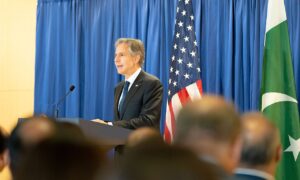The growth of nuclear power plants and radiological facilities and activities is increasing rapidly in South Asia. Besides the two nuclear giants, India and Pakistan, smaller countries are exploring nuclear energy options—Bangladesh, for instance, is currently constructing two nuclear power reactors. Sri Lanka has also recently approved exploring nuclear energy options for power development, while Nepal has recently invested in nuclear education and passed a bill related to managing nuclear resources after the discovery of high-grade uranium deposits. Along with being home to two nuclear weapons states, South Asia also faces threats from multiple non-state actors and extremist groups—which may rise with the U.S. departure from Afghanistan. Numerous deadly terrorist attacks in India, Pakistan, Afghanistan, and Bangladesh, in addition to regular features of illicit trafficking of humans, drugs, and arms across the borders demonstrate the vulnerabilities of the security system in this region. With the International Atomic Energy Agency (IAEA) documenting a high number of illegal activities involving nuclear and radiological materials globally, it is not an exaggeration to consider the possibility of terrorist attacks targeting nuclear and radiological facilities in South Asia. As a region that deals with multiple security threats that cross borders, including trafficking and non-state actors, it is imperative to question the effectiveness of the South Asian nuclear security order and revisit existing mechanisms for regional cooperation.
The growth of nuclear energy in the context of the vulnerable security situation, mainly aggravated by extremism and illicit trafficking, compels observers to re-evaluate tools for addressing non-traditional security threats to nuclear materials, including illicit trafficking and extremism, which requires multifaceted national, regional, and international efforts. There are currently no existing regional mechanisms working specifically on nuclear security, however, there are multiple regional frameworks which have the potential to be a starting point for dialogue on cross-border threats that could also pose a risk to nuclear sites—such as targeting transit of illicit materials or cooperation on combating threats from non-state actors. As reported in Table One, there are seven main regional and subregional tools operating in South Asia. This includes four regional tools: The South Asian Association for Regional Cooperation (SAARC), the South Asian Free Trade Area (SAFTA), the South Asian Network for Sustainable Development Goals (SANS), and the South Asia Forum (SAF) and the three subregional tools: the Bangladesh-Bhutan-India-Nepal (BBIN) initiative, the Bay of Bengal Initiative for Multi-Sectoral Technical and Economic Cooperation (BIMSTEC), and the South Asian Subregional Economic Cooperation (SASEC).1There is also a Nepal-based international non-governmental organization, the South Asia Watch on Trade, Economics and Environment (SAWTEE) working on trade, environment, and food security issues in South Asian countries which is not included in Table One.
As a region that deals with multiple security threats that cross borders, including trafficking and non-state actors, it is imperative to question the effectiveness of the South Asian nuclear security order and revisit existing mechanisms for regional cooperation.
These regional/subregional organizations are mainly for the promotion of trade, energy, and socio-cultural ties. While regional forums can offer opportunities for dialogue, shaping norms, and addressing cross-border issues and non-traditional security threats, forums in South Asia have been heavily criticized for not meeting their charter objectives and being derailed by regional rivalries. Furthermore, nuclear security has rarely factored into the scope of these regional mechanisms. However, as many of the threats to nuclear and radiological material in South Asia cut across borders, it is worthwhile to examine the existing mechanisms for regional dialogue. Amongst all regional and subregional tools, SAARC, an economic and geopolitical organization in South Asia founded in 1985 and BIMSTEC, a subregional group providing a link between South Asia and Indo-Pacific region established in 1997, have the mandate to deal with non-traditional security excluding military, political, and diplomatic conflicts and have the potential to serve as forums to address threats to nuclear and radiological materials
Methodology
This study uses both primary and secondary data. Primary data comes from several key informant interviews from subject matter experts, while secondary data includes scholarly articles, reports, and the charters and mandates of existing regional mechanisms in South Asia. Interviews were conducted via email with 16 structured questions. After contacting 35 security experts from India, Pakistan, and Bangladesh, I received six responses, one from India and five from Bangladesh, the gap in informant interviews was supplemented with analysis of secondary sources.
Role of existing tools in nuclear security
Tools for Addressing Threats from Non-State Actors
Among these organizations, SAARC’s charter and convention indicate that it is the only regional tool that has the multifaceted mandates to strengthen regional cooperation and address security threats, as well as cooperate with international and regional tools with similar aims. Other subregional tools do not have the same scope for maintaining peace and security in this region. However, while SAARC’s mandate has the potential to address an array of non-traditional security threats impacting nuclear security—most notably regional threats of terrorism—the regular postponement of summits and frequent disputes between member states has made the organization largely ineffective. For this reason, a South Asian law enforcement representative emphasized forming a new nuclear security platform due to SAARC’s ineffectiveness and the gravity of the threat of extremism and terrorism in this region.2According to a law enforcement representative of South Asia, “Success or failure of any cooperation depends on the equal importance of objectives set for that cooperation. More so, it also gets preference due to its strategic importance. Since IAEA is coordinating overall nuclear security of the world under the auspices of the UN, and all the countries of South Asia are the more or less perceiving threat of extremism and terrorism which may escalate to nuclear threat in the future, I think, regional cooperation in the field of nuclear security in South Asia may be an effective one.” However, the challenges SAARC has faced are unlikely to vanish with a new mechanism and using existing infrastructure and coordination mechanisms through SAARC is more practical and likely faster than getting each South Asian country to sign on to a separate exclusive tool for nuclear security. SAARC has set terrorism prevention within the organization’s mandate and goals, and reached additional agreements on curbing terrorist financing (although more can be done to implement these provisions). While SAARC does not address nuclear security in its current objectives, its charter empowers the organization to adapt to new areas of cooperation and develop new coordination mechanisms as deemed necessary of regional importance. Ultimately, the political will of the Indian and Pakistani governments will be the deciding factor.
As South Asia faces ongoing threats from multiple extremist groups across the subcontinent, nuclear security, in turn, becomes more complex and the consequences of nuclear security breaches more severe and borderless. Internationally, fears of nuclear terrorism and the vulnerabilities of radiological material escalated following the 9/11 attacks. Although some have questioned the scope of the nuclear terrorism threat, extremist groups have attacked nuclear energy plants and weapons sites across the globe, including a 2012 air force base attack by Tehrik-i-Taliban in Pakistan on a site thought to house nuclear weapons. In 2013, Indian police also found an improvised explosive device containing 1.5 kilograms of uranium in Assam, which was believed to be linked to the domestic separatist group the United Liberation of Assam. Osama bin Laden also indicated al Qaeda’s interests in nuclear technology, and affiliates of the Islamic State were said to be observing a Belgian nuclear scientist. Both India and Pakistan’s nuclear programs have vulnerabilities—with concerns over insider threats and unsafeguardednuclear materials. The new nuclear power entrants from the region may also fall prey to more vulnerabilities, which motivated non-state actors could exploit in the future.
Beyond SAARC, it may also be within the scope of BIMSTEC to address counterterrorism cooperation—although this is a subregional organization also incorporating countries from Southeast Asia around the Bay of Bengal. BIMSTEC has also established a counterterrorism and transnational crime wing led by India—although also does not deal with nuclear security. A regional tool in Southeast Asia, the Association of Southeast Asian Nations (ASEAN), which has recently worked with the IAEA in areas including nuclear science, technology, and safeguards may provide a useful starting point for strategies of incorporating nuclear security in SAARC’s mandate.

There is currently no regional/subregional framework or treaty for the safe movement of nuclear materials across borders. SAFTA, a free trade network established under SAARC, mandates trading of all products including manufactures and commodities in their raw, semi-processed, and processed forms. However, SAFTA mainly focuses on tariffs and barriers to trade rather than monitoring what’s transferred across the border. The customs cooperation agreement of SAARC countries mainly concentrates on trading regular goods and nuclear material has not been a particular focus. According to the Center for Nonproliferation Studies database, the only open-source database collecting information on trafficking of nuclear material, incidents of trafficking in South Asia are comparatively lower than the rest of the world. However, isolated events—such as the 2014 loss of radioactive material on a bus going across Nepal—underscore the need for regional organizations to play a role in establishing best practices and cooperative mechanisms as nuclear energy expands across the region.
SAARC still has a long way to go to address cross-border crime or trading of illicit materials. Once again, ASEAN’s structure can form a potential blueprint in integrating this aspect of security into the SAARC framework. Along with looking for greater opportunities for regional trade, ASEAN has also acknowledged challenges of cross-border crime and worked to set up border liaison offices across Southeast Asia. However, SAARC thus far has not followed this model—for instance, the decision taken in 2006 for the establishment SAARCPOL (modeled off INTERPOL) has yet to function.3M. Muzaffar, Iqra Yatool, and Zahid Yaseen; SAARC: An Evaluation of its Achievements, Failures, and Compulsion for Cooperation, Global Political Review, 2, No. 1, (2017), 36-45. However, other existing regional/subregional organizations in South Asia are broader in terms of their objectives or sole purposes and they do not even address to monitor and detect illicit trafficking across shared borders including nuclear security issues.4A nuclear security expert opines that: “Our effort of cooperation should be focused on the failures of the regional networks to be nuclear security-focused platforms in South Asia. Other subregional tools like SASEC, BBIN, etc. are particularly focused on trade and environment, energy and conventional security of these countries." As nuclear smuggling may potentially cross-borders, the prediction of high order nuclear security risk is not an exaggeration. As a region with long, shared, and often-porous borders, it is crucial to address and monitor the trade of any nuclear materials—as one expert put it, “pilferage or misappropriate of nuclear materials is a localized event, but its effect bears global dynamics.”5According to a nuclear security expert, “Pilferage or misappropriation of nuclear materials is a localized event, but its effect bears global dynamics. Even a non-nuclear state may fall prey to such terrorism with nuclear involvement”. In that sense, South Asian countries should also strengthen their cooperation on the security of nuclear material for peace and security.
One of the top mandated areas of cooperation within SAARC is energy and the SAARC energy centerdeals with the promotion and utilization of all energy resources, which may provide a further outlet for information sharing and best practices by connecting policymakers and academia. It appears by analyzing charters/mandates and objectives, SAARC is the appropriate institution to take initiative for the formation of a nuclear risk community as member countries are opting for more nuclear and other radioactive materials. It is highly unlikely, there will be a regional cooperation for operating nuclear power plants in South Asia for a responsible and sustainable nuclear future. Keeping in view this, the priority for the SAARC countries is to initiate regional dialogues for ensuring nuclear security in this region.6According to a security expert, “the agreements should be such that South Asian countries will be responsible to guard the nuclear material when it comes within the area of responsibility of each country."
Policy Implications
South Asian countries have ample reasons to work together for promoting more openness and transparency regarding nuclear security matters. South Asian regional organizations lag far behind groupings like ASEAN in terms of developing nuclear security architecture and global security commitments and standards. While SAARC remains at a standstill, other regional/subregional tools are not prepared to address nuclear security challenges and SAARC remains the best possibility for a regional approach to nuclear security. SAARC should be activated for maintaining the South Asian peace and prosperity by giving impetus to current extremism, terrorism, and global nuclear insecurity dynamics.
SAARC can look at ASEAN for potential avenues for this. For instance, SAARC countries can adopt ASEAN’s Network of Regional Bodies on Atomic Energy (ASEANTOM) strategy to unite all member states in nuclear security issues by conducting the heads of state meetings, summits, and dialogues amongst the foreign and home ministers for the formation of a nuclear security working group. SAARC can be used for sharing intelligence regarding information on adversary groups that might have access to illicit materials, border management, and nuclear or radiological emergency mechanisms. It can also be used for sharing experts and best practices, joint training, and coordinating with existing centers of excellence for nuclear security in India and Pakistan.
While SAARC remains at a standstill, other regional/subregional tools are not prepared to address nuclear security challenges and SAARC remains the best possibility for a regional approach to nuclear security.
Subregional tools may also work for improving the intra-regional relationship through resolving unresolved issues i.e., water and border disputes, transit, corridors, for building trust and relationship. Considering the potential consequences of any nuclear security events can be a starting point of dialogues between the two rival countries—India and Pakistan. Nuclear scientists and civil societies within SAARC countries should exert pressure to their respective countries to break the SAARC’s stalemate and use other regional tools to work more effectively. On the international level, organizations like the IAEA and the United Nations can urge South Asian countries to be responsive to the international safety and security norms and practices for the enhancement of nuclear security governance.
If these pathways fail to move forward with nuclear security challenges, there is a necessity to form a nuclear security forum in South Asia for maintaining peace, security, and prosperity. It can at least start a trilateral nuclear security cooperation forum (Bangladesh, India, and Pakistan) like the existing tri-nation nuclear cooperation model comprising the three nuclear power countries i.e., Bangladesh, India, and Russia.7Rana M.S., Islam M.S., "The Logic Behind Trilateral Model for Implementing the First Nuclear Power Plant in Bangladesh," BIISS Journal, 42, No.2 (2021),107-129. Under the tri-nation nuclear security forum, member states can work together on terrorism and nuclear security vulnerabilities by taking appropriate strategies, plans, and measures.
Notes
- 1There is also a Nepal-based international non-governmental organization, the South Asia Watch on Trade, Economics and Environment (SAWTEE) working on trade, environment, and food security issues in South Asian countries which is not included in Table One.
- 2According to a law enforcement representative of South Asia, “Success or failure of any cooperation depends on the equal importance of objectives set for that cooperation. More so, it also gets preference due to its strategic importance. Since IAEA is coordinating overall nuclear security of the world under the auspices of the UN, and all the countries of South Asia are the more or less perceiving threat of extremism and terrorism which may escalate to nuclear threat in the future, I think, regional cooperation in the field of nuclear security in South Asia may be an effective one.”
- 3M. Muzaffar, Iqra Yatool, and Zahid Yaseen; SAARC: An Evaluation of its Achievements, Failures, and Compulsion for Cooperation, Global Political Review, 2, No. 1, (2017), 36-45.
- 4A nuclear security expert opines that: “Our effort of cooperation should be focused on the failures of the regional networks to be nuclear security-focused platforms in South Asia. Other subregional tools like SASEC, BBIN, etc. are particularly focused on trade and environment, energy and conventional security of these countries."
- 5According to a nuclear security expert, “Pilferage or misappropriation of nuclear materials is a localized event, but its effect bears global dynamics. Even a non-nuclear state may fall prey to such terrorism with nuclear involvement”. In that sense, South Asian countries should also strengthen their cooperation on the security of nuclear material for peace and security.
- 6According to a security expert, “the agreements should be such that South Asian countries will be responsible to guard the nuclear material when it comes within the area of responsibility of each country."
- 7Rana M.S., Islam M.S., "The Logic Behind Trilateral Model for Implementing the First Nuclear Power Plant in Bangladesh," BIISS Journal, 42, No.2 (2021),107-129.




